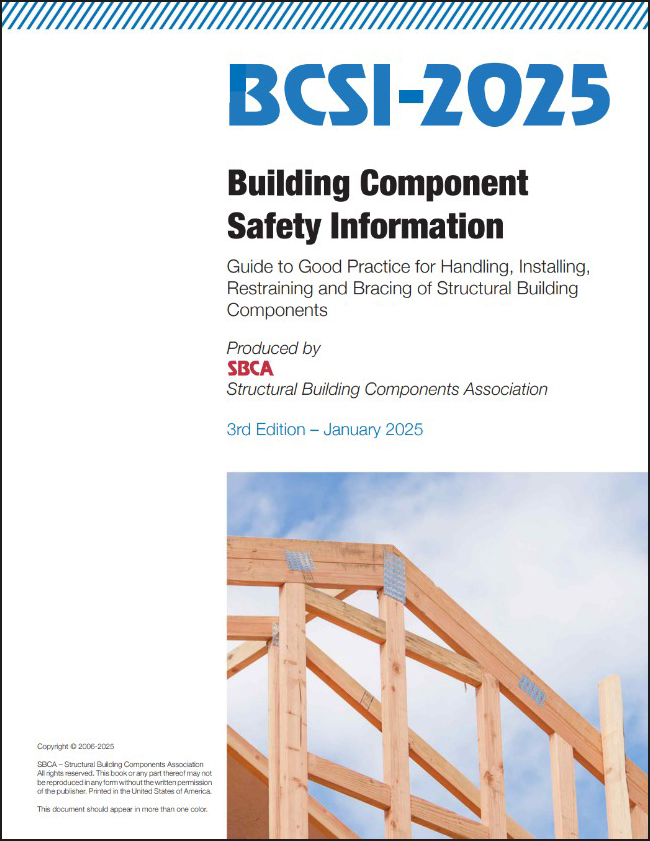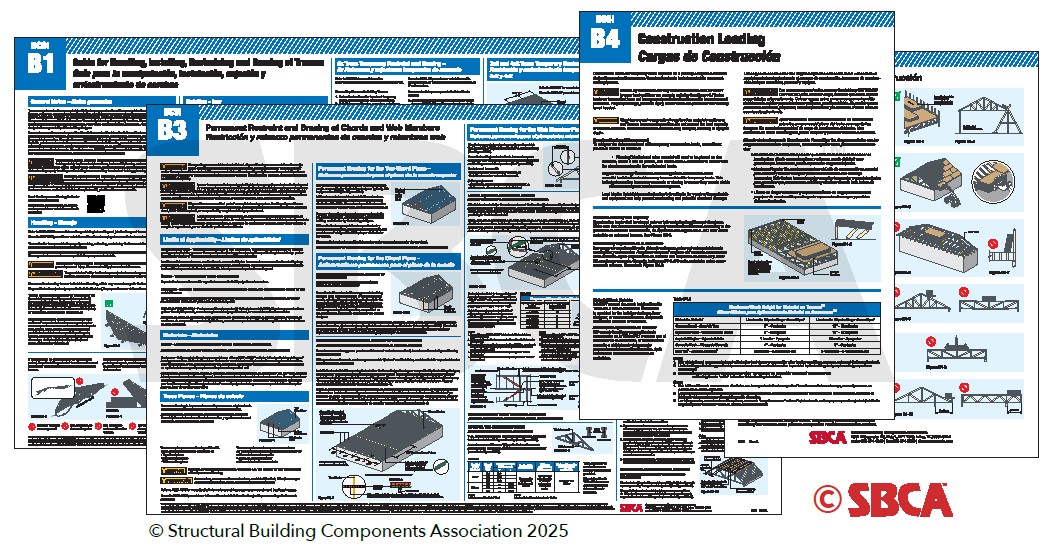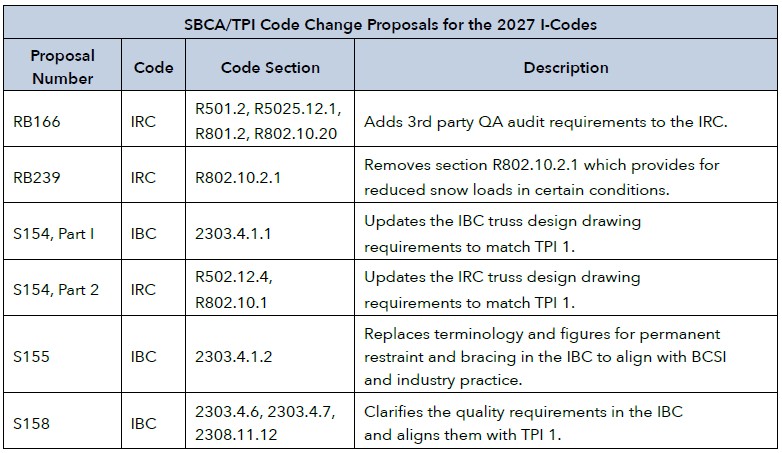More Than a Guide to Good Practice
From Jobsite Tools to Code Development, Progress is Underway
By Greg Greenlee, P.E.

Earlier this year, SBCA finished a process of updating and reorganizing the BCSI guide, and thereafter approved, and published the new BCSI-2025, Building Component Safety Information - Guide to Good Practice for Handling, Installing, Restraining and Bracing Structural Building Components. A broad committee of 17 individuals, plus SBCA staff members, was formed to update the BCSI guide to ensure the safety and prescriptive bracing recommendations contained in the guide are relevant, technically correct, and practical. With the importance of bracing in mind, the committee recognized that in order for bracing to be effective, it must be properly installed. To help ensure proper installation, great effort was put into making the guide easier to understand. Contributions from members of the National Framers Council (NFC) were invaluable on the bracing topic.
While many of the changes incorporated in BCSI-2025 are layout and visual ones, new content was added to describe the component design and approval process, code requirements, and jobsite planning. Prescriptive temporary bracing recommendations were enhanced, and new permanent bracing recommendations were added. Additionally, the guide utilizes chapters, section numbers, a single-column format, updated graphics, and refined defined terms. Looking forward, the guide is on a three-year development cycle, with interim updates as necessary.
 After BCSI-2025 was completed, work began on updating the B-Series Sheets that are derived from the BCSI guide and provided within the SBCA Jobsite Packages and available individually. The committee recognized that the existing names of the documents, B1, B2, B3, etc., are part of the construction industry vernacular, so the decision was made to maintain the current names of these sheets. The content of the B-Series Sheets was ultimately updated to correspond to the information and recommendations in the new BCSI guide. The scope of B10 was realigned to match the Post Frame Construction chapter in BCSI-2025. Recommendations relating to the installation of trusses spaced more than two feet on center were removed from B10 and are now included in a new B6 Sheet.
After BCSI-2025 was completed, work began on updating the B-Series Sheets that are derived from the BCSI guide and provided within the SBCA Jobsite Packages and available individually. The committee recognized that the existing names of the documents, B1, B2, B3, etc., are part of the construction industry vernacular, so the decision was made to maintain the current names of these sheets. The content of the B-Series Sheets was ultimately updated to correspond to the information and recommendations in the new BCSI guide. The scope of B10 was realigned to match the Post Frame Construction chapter in BCSI-2025. Recommendations relating to the installation of trusses spaced more than two feet on center were removed from B10 and are now included in a new B6 Sheet.
SBCA Knowledge Center
At the beginning of 2025, SBCA launched its new Knowledge Center. The Knowledge Center is an extensive library of free downloadable content including research reports, white papers, presentations, and videos. The entire focus of the Knowledge Center is on structural building components and the greater construction industry. Also, this past year, SBCA’s E&T Committee has been reviewing and updating existing technical documents as well as developing new material to address the latest issues facing the component industry. Specifically, technical notes discussing the new snow load provisions in ASCE 7-22 and the 300-pound person load requirement in ANSI/TPI 1-2022 have been published, with more new technical notes on the way.
2024 I-Code Changes
New versions of the IBC and IRC were released in 2024. Some jurisdictions adopt each new version of the code that is published, while others choose to skip some cycles. States and local jurisdictions looking to adopt the 2024 versions are starting to make the transition. It is important to highlight that the 2024 version of the codes reference ANSI TPI 1-2022, and changes from ANSI/TPI 1-2014 to ANSI/TPI 1-2022 will be included in the 2024 version of the IBC and IRC as well.
While the number and significance of changes relative to wood floor and roof trusses are less compared to previous code cycles, there are a few important ones that need to be highlighted.
- IRC Guard Support Around Openings. A new Section R502.11 adds language requiring that the edge framing be capable of resisting the lateral overturning moment from a lateral guard rail support load applied at a height of 44 inches above the floor. SBCA will be developing details for the use of floor trusses that comply with these new provisions. The new details will also be part of a new technical document and be included in the Knowledge Center.
- IBC Wood Truss Permanent Bracing. Standard industry details for permanent lateral restraint and permanent diagonal bracing, piggyback truss permanent bracing, and truss web member reinforcing derived from the BCSI guide were added to Section 2303.4. This was introduced in the 2021 IBC, but will be new for jurisdictions transitioning from the 2018 or older versions of the IBC. Additionally, language was added to specify the three methods by which permanent restraint and bracing can be provided. These include standard industry details, individual truss member reinforcement (i.e. T-reinforcement), and a project-specific permanent restraint and bracing design. This aligns with language in ANSI/TPI 1 and BCSI.
- 300-Pound Person Load. This is a new provision in ANSI/TPI 1-2022, which is the referenced standard in the 2024 IBC and 2024 IRC. The provision adds a new person loading check in Section 6.2.2.5 to represent the occurrence of a person on the chord of a roof truss. This provision only applies to chords not sheathed with structural wood sheathing and was introduced to enhance safety by ensuring that truss chords can support a worker during temporary conditions, such as access for maintenance or installation activities. It is important to note that because the load is required in addition to any load cases required for the applicable end use, it is not solely intended to be a construction load but certainly serves that purpose as well. Additionally, it should be noted that the provision does not explicitly limit the application of the load to the truss bottom chord. Rather, it specifies that the load should be applied “at the mid-point of any chord panel”. Therefore, the provision applies anywhere sheathing is not directly applied, including top chords where that condition exists.
 2027 I-Code Change Proposals
2027 I-Code Change Proposals
The 2027 code development cycle began this year. SBCA, together with TPI, introduced six code change proposals. The code development cycle is a comprehensive and lengthy process involving three separate hearings where the proposals are reviewed, discussed, and voted upon. So far, the proposals have been heard at the first meeting, the Committee Action Hearing #1. The second meeting will be Committee Action Hearing #2, which will be held in October 2025. See the adjacent table for a summary of the code change proposals submitted by SBCA and TPI for the 2027 code development cycle.
